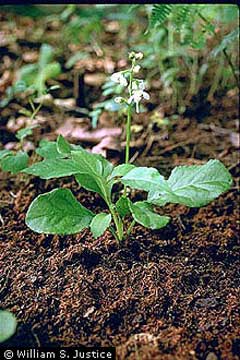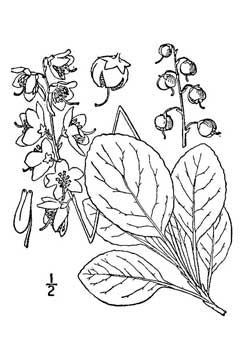 |
|
William S. Justice @ USDA-NRCS PLANTS Database |
 |
| USDA-NRCS PLANTS Database / Britton, N.L., and A. Brown. 1913. An illustrated flora of the northern United States, Canada and the British Possessions. 3 vols. Charles Scribner's Sons, New York. Vol. 2 |
Translate this page:
Summary
Physical Characteristics

 Pyrola elliptica is an evergreen Perennial growing to 0.2 m (0ft 8in) by 0.3 m (1ft).
Pyrola elliptica is an evergreen Perennial growing to 0.2 m (0ft 8in) by 0.3 m (1ft).
See above for USDA hardiness. It is hardy to UK zone 3. It is in leaf all year, in flower from June to July. The species is hermaphrodite (has both male and female organs) and is pollinated by Insects. The plant is self-fertile.
Suitable for: light (sandy) and medium (loamy) soils. Suitable pH: mildly acid and neutral soils and can grow in very acid soils.
It can grow in full shade (deep woodland) semi-shade (light woodland) or no shade. It prefers moist soil.
UK Hardiness Map
US Hardiness Map
Synonyms
Plant Habitats
Woodland Garden Dappled Shade; Shady Edge; not Deep Shade;
Edible Uses
References More on Edible Uses
Medicinal Uses
Plants For A Future can not take any responsibility for any adverse effects from the use of plants. Always seek advice from a professional before using a plant medicinally.
Analgesic Ophthalmic Tonic Vulnerary
The leaves have analgesic properties and were used as a poultice on bruised shins and other sores and wounds[207, 222, 257]. A tea made from the whole plant was used to treat epileptic fits in babies[222, 257]. A decoction of the whole plant has been used as eye drops to treat sore eyes, sties and inflamed eyelids[257]. A tea made from the leaves was used as a gargle for sore throats and cankers in the mouth[222, 257]. A tea made from the roots is tonic[222].
References More on Medicinal Uses
The Bookshop: Edible Plant Books
Our Latest books on Perennial Plants For Food Forests and Permaculture Gardens in paperback or digital formats.

Edible Tropical Plants
Food Forest Plants for Hotter Conditions: 250+ Plants For Tropical Food Forests & Permaculture Gardens.
More

Edible Temperate Plants
Plants for Your Food Forest: 500 Plants for Temperate Food Forests & Permaculture Gardens.
More

More Books
PFAF have eight books available in paperback and digital formats. Browse the shop for more information.
Shop Now
Other Uses
References More on Other Uses
Cultivation details
Prefers a moist sandy woodland soil[111, 200] in a cool position with partial shade[1, 11, 200]. Requires a peaty or leafy acid soil that remains moist in the summer[200]. The flowers have a delicate sweet perfume[245]. This is a very difficult plant to grow. It requires a mycorrhizal relationship in the soil and therefore needs to be grown initially in soil collected from around an established plant[200]. It is also very difficult from seed as well as being intolerant of root disturbance which makes division difficult[1]. This species is extremely rare and endangered in the wild[200].
References Carbon Farming Information and Carbon Sequestration Information
Temperature Converter
Type a value in the Celsius field to convert the value to Fahrenheit:
Fahrenheit:
The PFAF Bookshop
Plants For A Future have a number of books available in paperback and digital form. Book titles include Edible Plants, Edible Perennials, Edible Trees,Edible Shrubs, Woodland Gardening, and Temperate Food Forest Plants. Our new book is Food Forest Plants For Hotter Conditions (Tropical and Sub-Tropical).
Shop Now
Plant Propagation
Seed - the only information we have on this species is that it is difficult from seed and germinates infrequently[200]. We would suggest sowing the seed as soon as it is ripe if this is possible. Sow it into soil collected from around an established plant, only just covering the seed, and put the pot in a shady part of a cold frame. Pot up any young seedlings as soon as they are large enough to handle, once again using soil from around an established plant. Plant out into their permanent positions when the plants are large enough. You should not need to use soil from around an established plant to do this since the soil in the pot will contain the necessary micorrhiza. Division with great care in the spring[1, 111]. Pot up the divisions using some soil from around an established plant, grow on in a lightly shaded part of a greenhouse or frame and do not plant out until the plants are growing away vigorously[200].
Other Names
If available other names are mentioned here
Native Range
NORTHERN AMERICA: Canada (Québec, Nova Scotia, Prince Edward Island, New Brunswick, Newfoundland and Labrador, British Columbia), United States (Connecticut, Massachusetts, New Hampshire, New York, Pennsylvania, Rhode Island, Vermont, Minnesota, Nebraska, North Dakota, South Dakota, Wyoming, New Mexico)
Weed Potential
Right plant wrong place. We are currently updating this section.
Please note that a plant may be invasive in one area but may not in your area so it's worth checking.
Conservation Status
IUCN Red List of Threatened Plants Status :

Growth: S = slow M = medium F = fast. Soil: L = light (sandy) M = medium H = heavy (clay). pH: A = acid N = neutral B = basic (alkaline). Shade: F = full shade S = semi-shade N = no shade. Moisture: D = dry M = Moist We = wet Wa = water.
Now available:
Food Forest Plants for Mediterranean Conditions
350+ Perennial Plants For Mediterranean and Drier Food Forests and Permaculture Gardens.
[Paperback and eBook]
This is the third in Plants For A Future's series of plant guides for food forests tailored to
specific climate zones. Following volumes on temperate and tropical ecosystems, this book focuses
on species suited to Mediterranean conditions—regions with hot, dry summers and cool, wet winters,
often facing the added challenge of climate change.
Read More
Expert comment
Author
Nutt.
Botanical References
200235
Links / References
For a list of references used on this page please go here
Readers comment
© 2010, Plants For A Future. Plants For A Future is a charitable company limited by guarantee, registered in England and Wales. Charity No. 1057719, Company No. 3204567.